How successfully you perform at an important competition, whether it is a local show, a special class at a rated show or a regional or national championship, depends upon how effectively you plan your training in the weeks leading up to it. The better prepared you and your horse are, the more confident you will feel and the more mentally and physically fit you will be for the task at hand. Over the long term, properly preparing your horse for every show will also help to keep him happy, healthy and sound—helping to extend his competitive career.
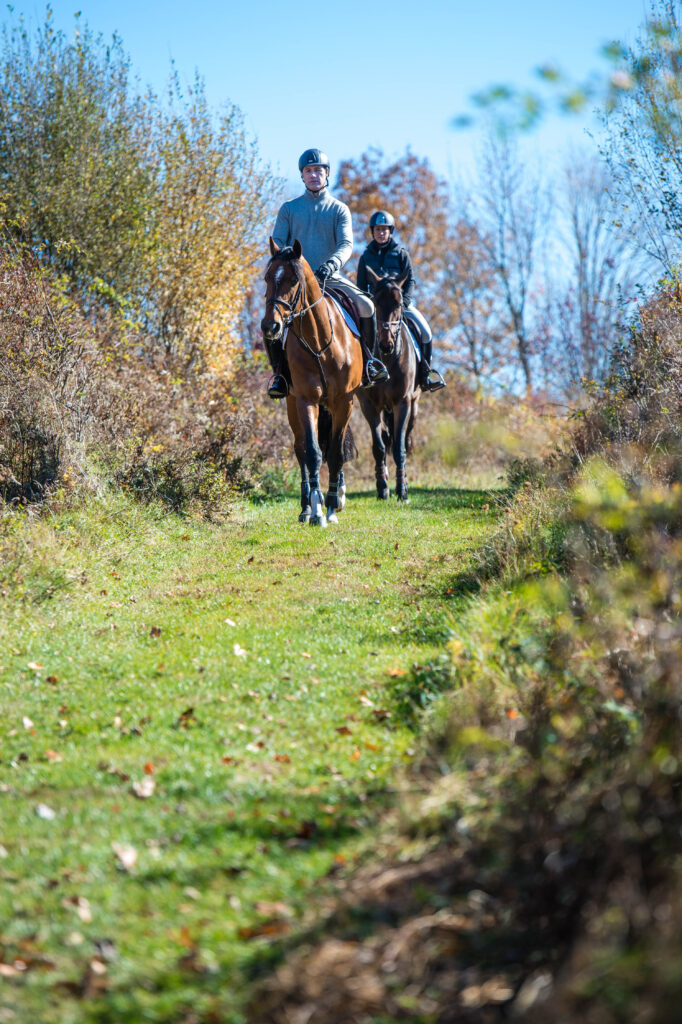
The key to a good show-prep plan is to tailor it to your and your horse’s needs. Evaluate every factor in your own situation. How experienced are you at this level? How long ago was your last show? Is it the season’s start and you are feeling a little rusty? Or are you at the end of a long stretch of showing and feeling the need for some downtime to refresh? Do you have a particular skill that needs improvement? Try to think of every variable that might affect your performance.
Evaluate the Competition Venue
Next, consider the specific competition venue and type of classes you are entering. Evaluate the size, footing, terrain and visuals of the competition arena. Is it on sand or grass? Indoors or outdoors? What types of jumps will there be? Will there be any new questions that you and/or your horse have never encountered before? If so, it is extremely important that you make the time to introduce yourselves to these new challenges at home beforehand. Attempting to do something new at a show is unfair to yourself and your horse.
To be successful in each competition, you need to develop the appropriate sense of rhythm and timing for that particular venue. For example, on the long tracks of outdoor grand prix fields, there often are 20 strides between fences, so you have to be careful not to venture off course and pick up time faults. In the smaller space of an indoor arena, at the other extreme, there frequently are only four to six strides between fences, so you have to look for them sooner and react more quickly to what is happening on course. Training in a venue comparable to the one in which you plan to compete will help you develop the appropriate timing and mind-set.
Practicing ahead of time in a similar environment and on comparable surfaces will also allow you to make any necessary tack adjustments, which is always better to do before arriving on the showgrounds. For example, if you will be competing in a larger ring with a wider variety of terrain (hills, banks, etc.) than you are used to, you may find you need a different bit than you use in a smaller ring.
If this venue is new to you, read the prize list carefully and take advantage of all the great resources online. Check the show website and search for photos and videos from previous years. YouTube hosts a plethora of videos from most big shows and many smaller ones. Riders often share videos, too, on other social-media sites, such as Facebook. As you watch these videos, take note of the ring characteristics, jump materials and anything else that appears new or different to you.
Make a Plan
Now lay out a plan for the four weeks leading up to the show. (Note: A four-week time frame assumes that you and your horse already have a basic level of fitness and are show-ready. If this is not the case, schedule additional time to develop this base.) For each week, identify what you plan to focus on, what your goals are and what facilities you will need to accomplish them. Schedule the bulk of your fitness work and exposure to different terrain/obstacles in the earlier weeks so your horse has time to acclimate to them. With careful planning, you can cover a lot of ground in the first three weeks so you will be free to spend much of the last week polishing your course-riding skills and fine-tuning your performance.
If your barn does not provide the same type of arena that you will encounter at the show, locate a nearby facility to trailer to for practice sessions. For example, if you will be showing indoors but do not have an indoor arena at your barn, it is worth paying a ship-in fee to use another barn’s arena. If you will be competing on grass and you do most of your riding in a sand ring, getting your horse out onto natural footing is critical. If your only access to open space is a horse pasture, evaluate the footing carefully before trotting, cantering and jumping on it. Poorly maintained, uneven ground can increase the risk of injuries.
If you will be competing over natural jumps—water, ditches, etc.—and do not have them at your barn, find a qualified instructor who can school you over the jumps in a lesson or clinic. Get creative, too. If you come across an appropriately sized fallen log, place it in your arena to school over. Add straw bales, flowers and brush as jump fillers to expose your horse to the types of questions he will encounter at the show.
Take the time to write out your goals for each week in the lead-up to the show. Then make an entry for every day of the week, describing where you plan to ride and what you plan to do (jump school, dressage, trail ride, etc.).
To illustrate how to design an effective four-week training plan, I am going to share the one I followed last spring to prepare horses for the jumper divisions in the grand prix field at the Old Salem Farm Horse Show in New York, after they had shown on sand all winter. Although these are top-level horses, my plan should give riders of all levels some insight into the thought process that can be applied in preparation for any competition.
Sample Training Plan: Prepping for the Jumper Divisions At Old Salem Farm
In this example, my horses had spent four months over the winter in Florida for competitions. After we returned to our summer base in North Salem, New York, in April, they had a couple of weeks of rest and turnout between the end of the winter circuit and spring training. Because they are seasoned show horses with a lot of courses already under their belts, my four-week plan was less about practicing jumps and more about getting them outside the ring, both to revitalize them mentally and physically and to expose them to the type of environment they would encounter at Old Salem. In Florida, they had worked almost exclusively in flat sand rings. They needed time to adjust to the different physical demands and feel of the large, grassy field at Old Salem and prepare for its natural obstacles, which include a natural bank, grob (sunken road), ditch and open water.
WEEKS 1 & 2
Focus: Trail and cross-country riding, jumping natural obstacles
Goal: Fitness improvement, adjusting
to natural/grass surfaces and open spaces, refamiliarizing horses and riders with
natural obstacles
Requirements: Access to open fields and trails with good footing and natural obstacles (bank, water, liverpool, ditch, etc.)
In North Salem, we are fortunate enough to be surrounded by a shared trail system and a publicly owned open preserve. In the first two weeks of this training plan, we take advantage of this beautiful landscape and get the horses outside the ring as much as possible—six days a week, if the weather allows. We walk and trot on the dirt roads and trails. When the horses have settled into the new environment—and if the grass fields are dry enough—we canter in them as well. Otherwise, we may come back to the ring at the end of a trail ride to get in a little canter work.
In the first week, we find gradual hills to walk and trot up and down. The second week, we find slightly steeper ones. Because the varying terrain requires you to adjust your weight constantly to stay in balance with the horse, this is an excellent strengthening exercise for riders, too. On the hills, you need to stay lighter in your seat, keeping your weight off your horse’s back. While out on the trails, we also hop over small logs and other little, safe natural obstacles we come across.
Riding out is fun and exciting for both horses and riders. There is a greater element of surprise, though—for example, when you come across wildlife on the trail—so I remind my riders to stay alert and keep their heels down in case of a spook. We also like to ride out in pairs both for safety’s sake and so horses and riders can provide company and support for each other.
In Week 2, I plan two schooling sessions over natural fences for my jumpers. Most of them are already familiar with natural jumps. The ones I school them over are smaller than show-ring dimensions. The purpose here is to let them know to expect more than the common gate/flower-box obstacles they see in regular classes. There is no need to repeat natural fences unnecessarily. If a horse jumps them comfortably and confidently in the first schooling session, I keep that session brief and either skip the second session later in the week or make it very short and simple.
If I were preparing for a different venue, such as an indoor championship, I would spend some time working indoors during these first two weeks. But I would still try to get my horses outside on the trails and fields a few times, if possible. An occasional change of scenery helps to keep them interested in their work.
Weeks 1 & 2: Getting out of the Ring
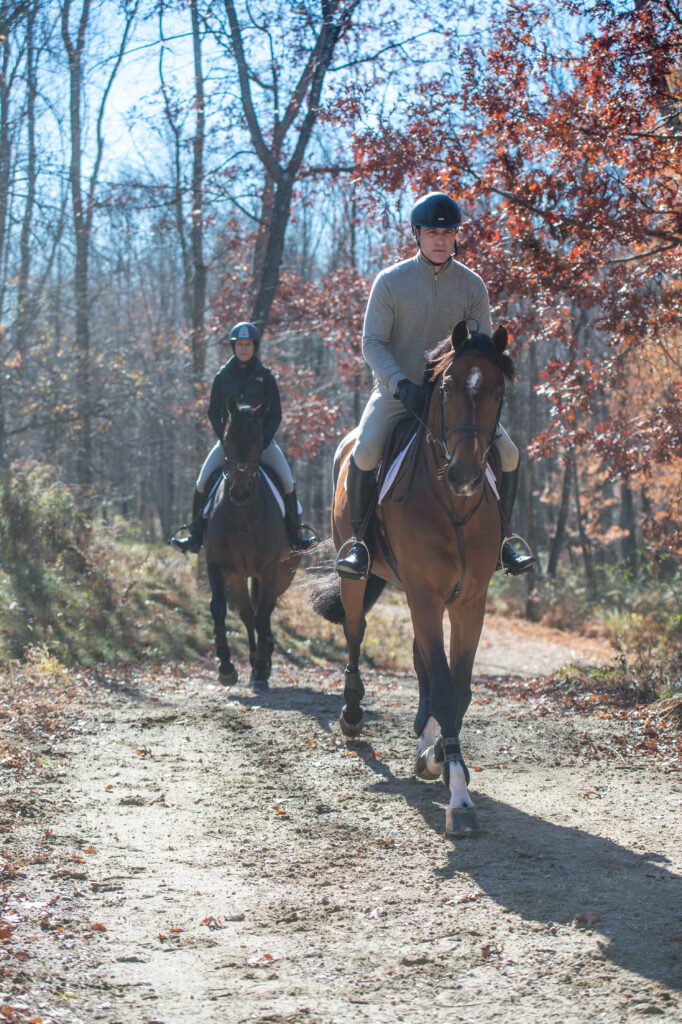
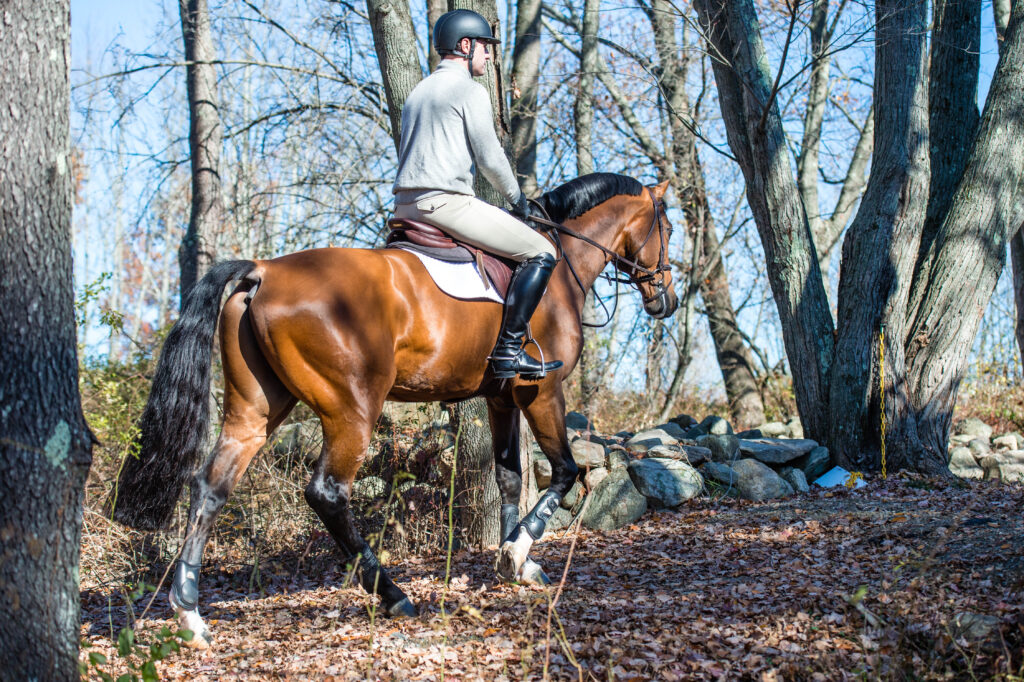
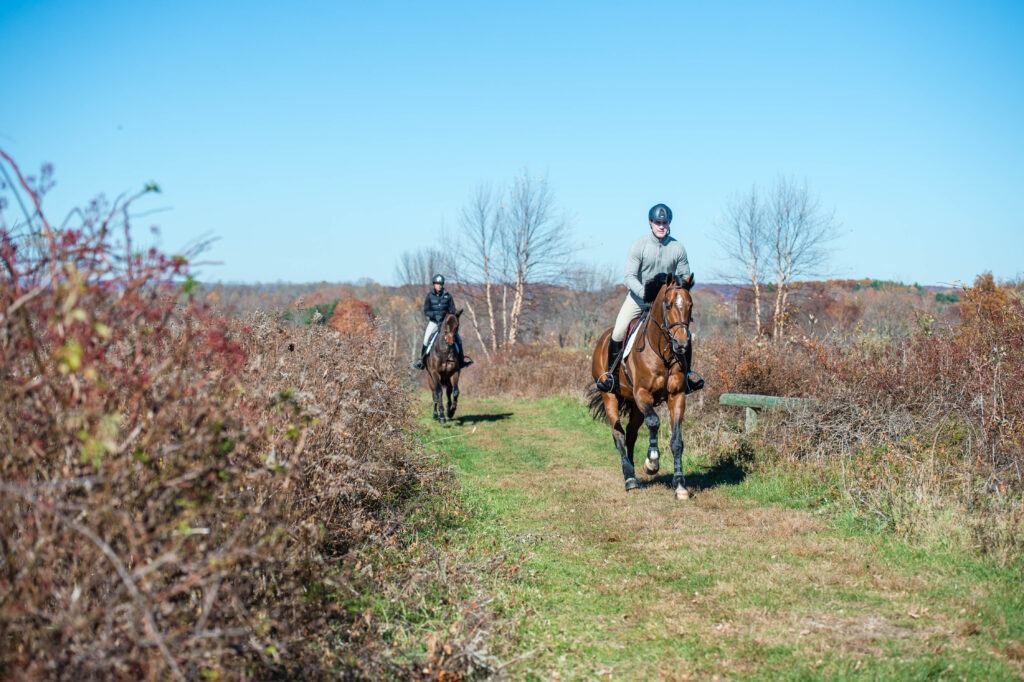
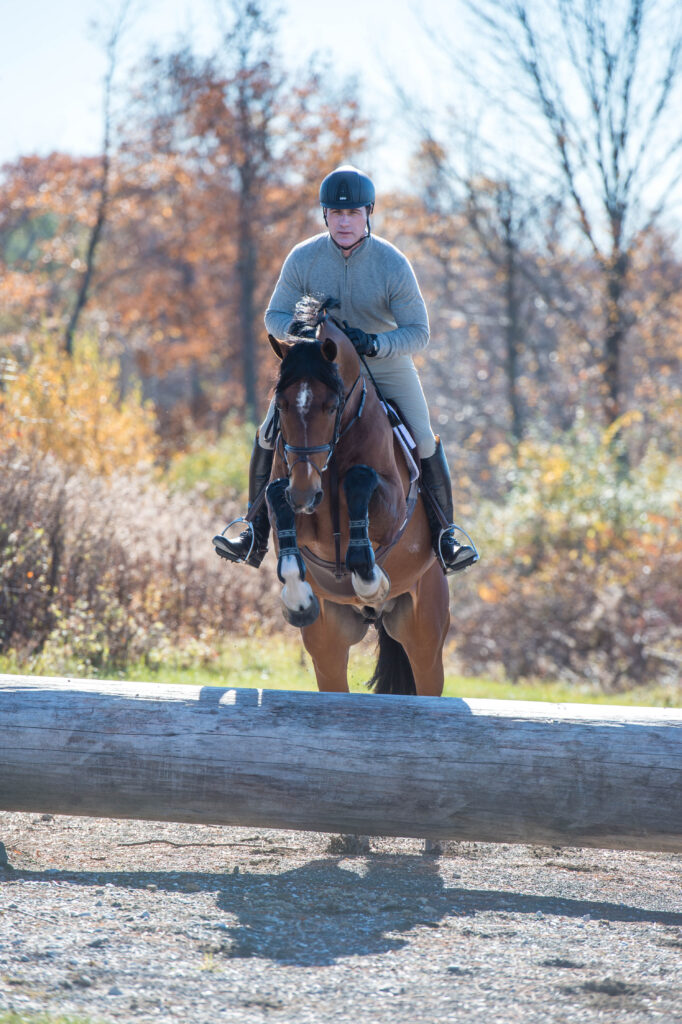
Weeks 1 & 2: Bank Sequence
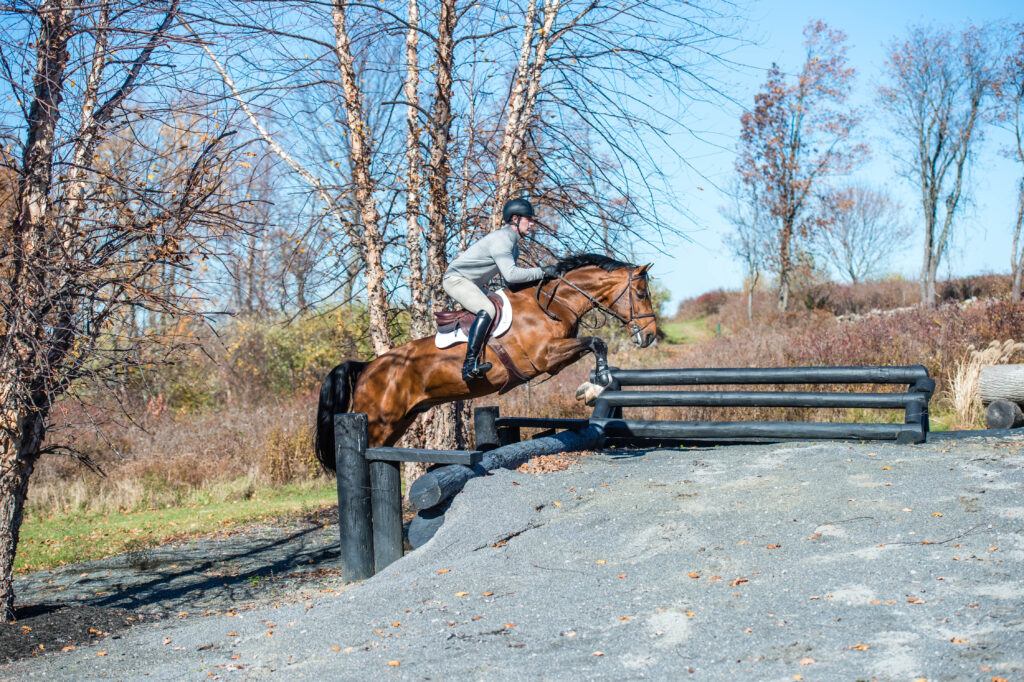
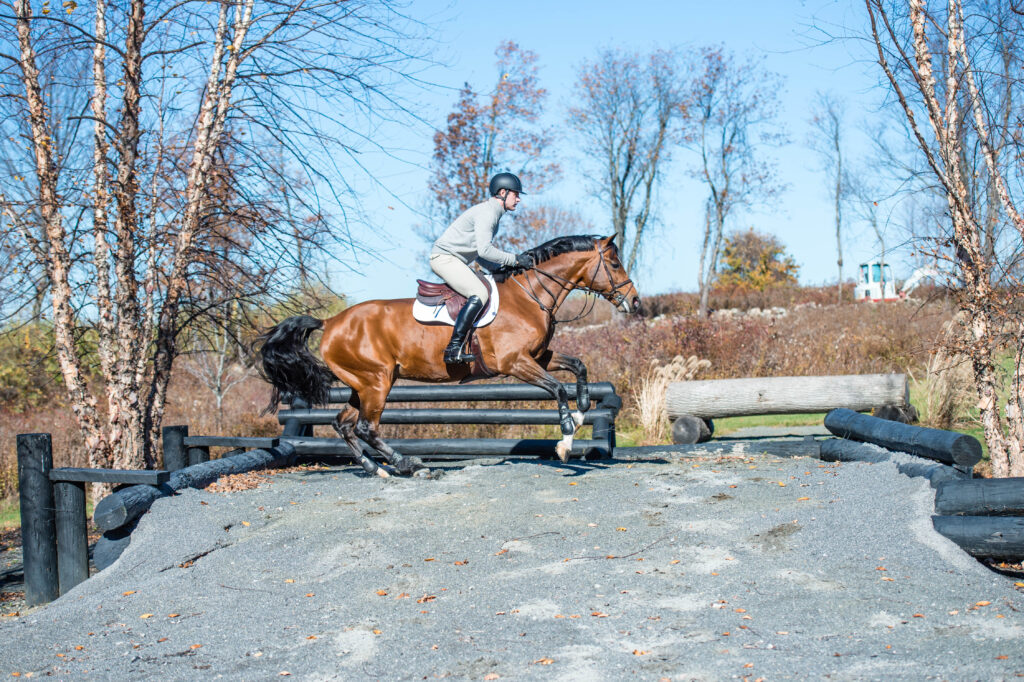
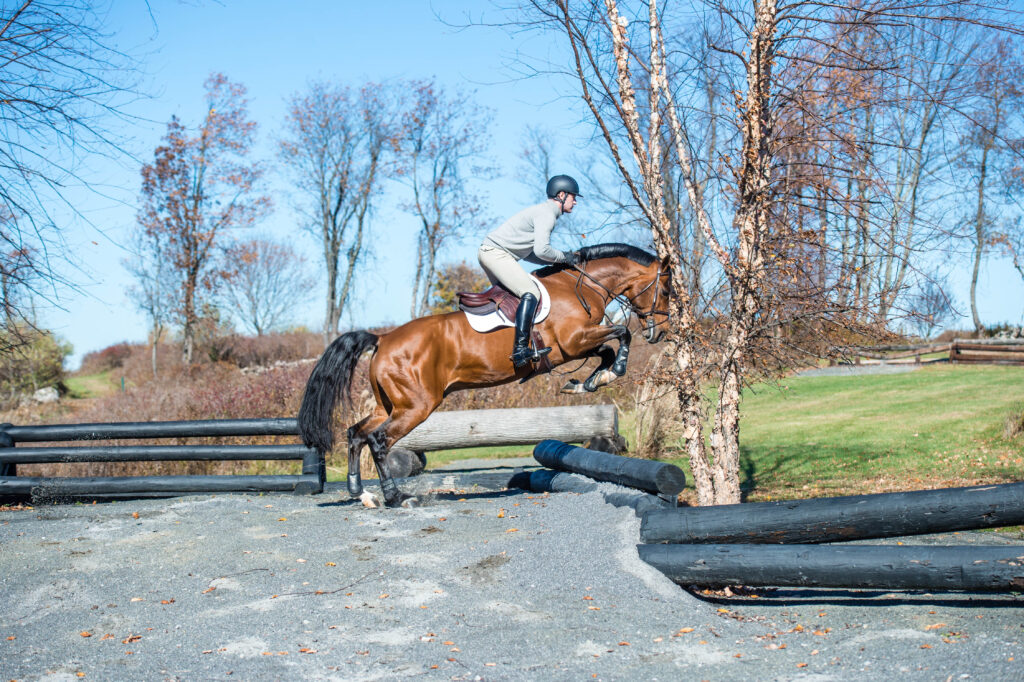
Week 3
Focus: Gymnastics
Goal: Working on horse’s straightness and jumping technique and rider’s position and balance
Requirements: At least four jump standards and seven poles, measuring tape and a ground person
I always have a gymnastic exercise set up in my ring. It is a great tool for encouraging good jumping technique while allowing the rider to focus on her position and balance. Gymnastics also engage horses mentally, asking them to pay attention to the questions in front of them. I like using crossrails in gymnastics to promote straightness and keep horses in the middle of the fences. The more advanced the horse, the higher I raise the cups.
One of my favorite gymnastic exercises is a series of three crossrails, set up in a row, with one canter stride (18 to 21 feet) between each. I also place bounce rails 9 feet before the first jump and after the last jump and between each jump. The bounce rails between crossrails improve both the horse’s and rider’s rhythm. If you are a beginner or intermediate rider or your horse is green, plan to trot into the exercise and canter out. More advanced riders and horses can canter to it. In either case, adjusting the distances to match your horse’s natural stride is always important.
I always begin by placing the rails on the ground, starting with the first bounce rail and a single rail between the first set of standards. I trot over this several times, adding another rail (the next bounce rail or rail between standards) after each pass. Riding over the rails introduces the concept to the horse gradually and allows you to safely determine if the distances are too long or short before building the jumps. Having a ground person on hand is extremely helpful. He or she can watch you ride over the rails on the ground, see where your horse’s feet land and take off, then adjust the rails accordingly.
After my horse is comfortably going over the ground poles, I build a single crossrail between the first set of standards and jump it several times. When that is going well, I add the second crossrail and the bounce rail after it. Eventually, I add the third crossrail with a final bounce rail after it. Each time I ride my horse through, I focus on staying light in the saddle, maintaining a connection with his mouth while concentrating on balancing my weight in the middle of the horse.
I use a similar gymnastic exercise to encourage horses to stretch over the fences by incorporating oxers. I start again with a crossrail, but this time follow it with one stride to an oxer and another stride to another oxer with no bounce rails. I make the oxers rampy—with the front rail a few holes lower than the back rail. As with the first exercise, I start with all the rails on the ground, then build up slowly, first jumping just the crossrail, then adding the oxers one at a time.
I usually schedule these two gymnastic schools two or three days apart during the third week. For the rest of Week 3, I do dressage/ring work and try to get outside the ring at least one day. Again, regardless of the specific venue you are preparing for, an occasional change of scenery will do your horse good.
Week 3: Gymnastic Exercise 1, Crossrail–Crossrail–Crossrail
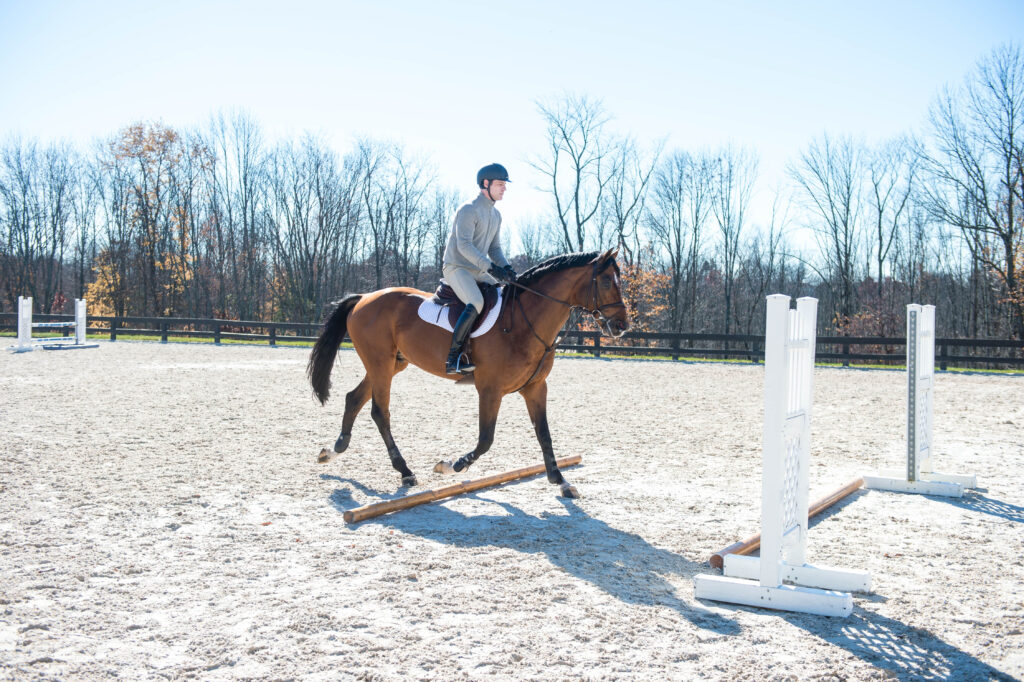
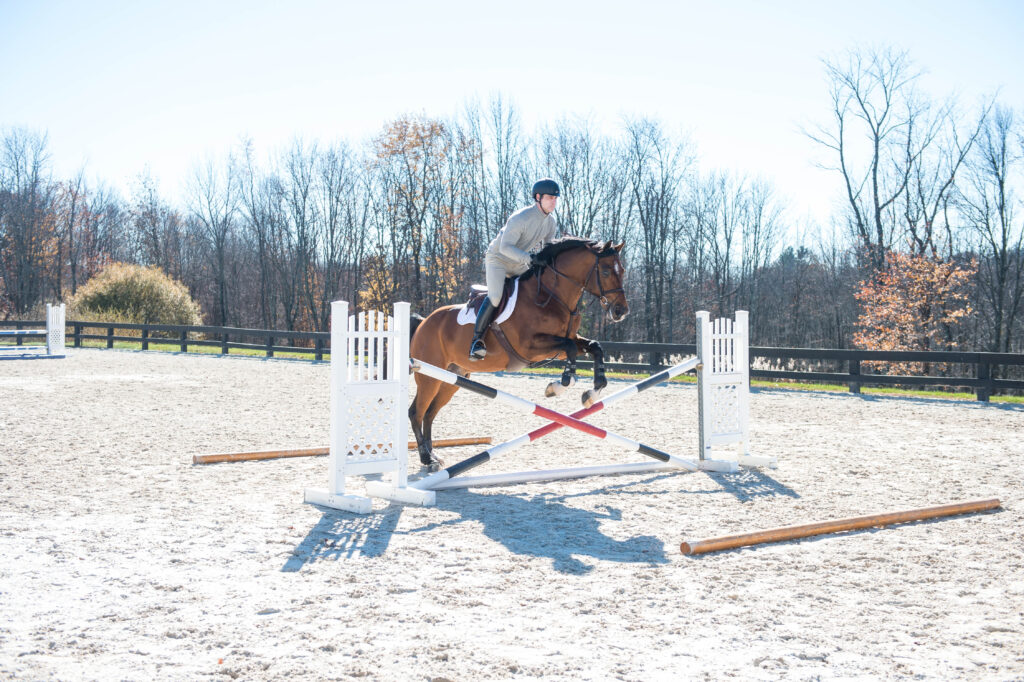
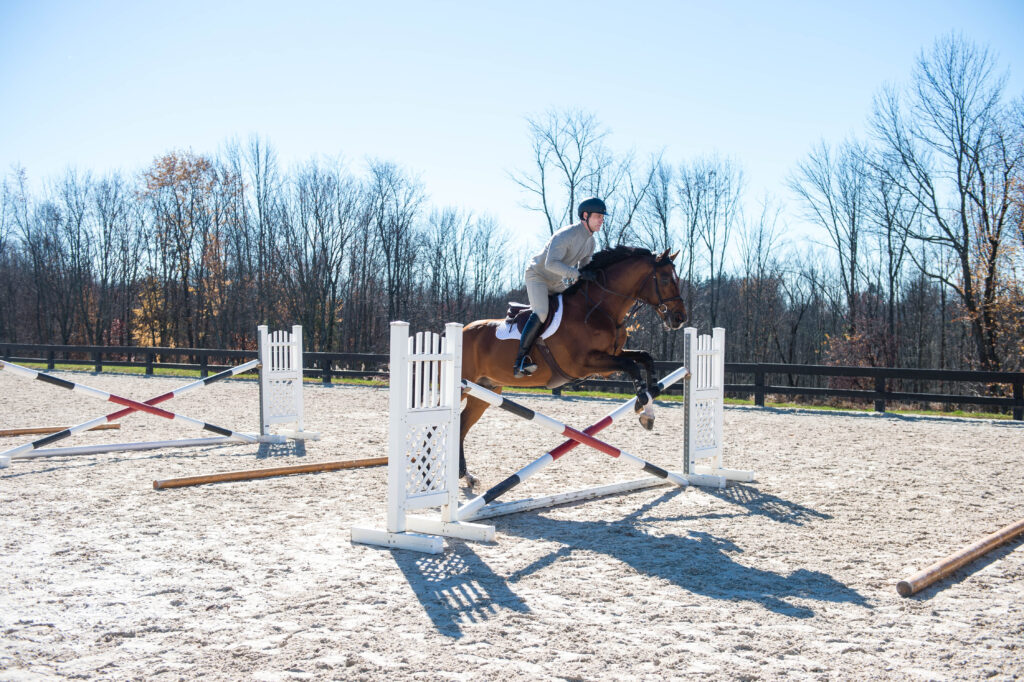
Week 3: Gymnastic Exercise 2, Crossrail–Oxer–Oxer
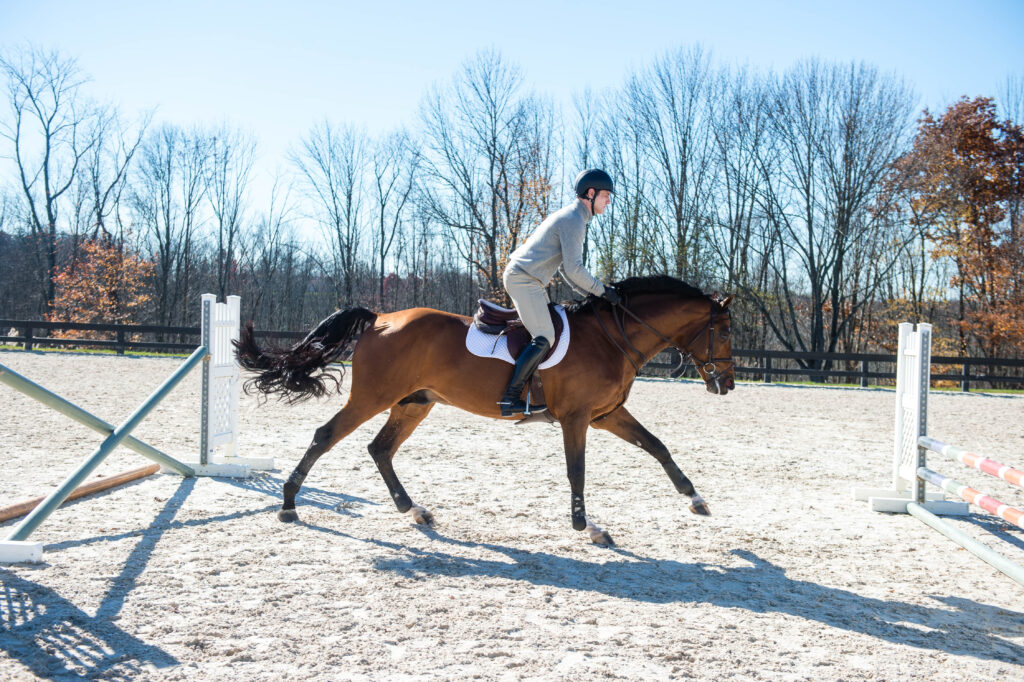
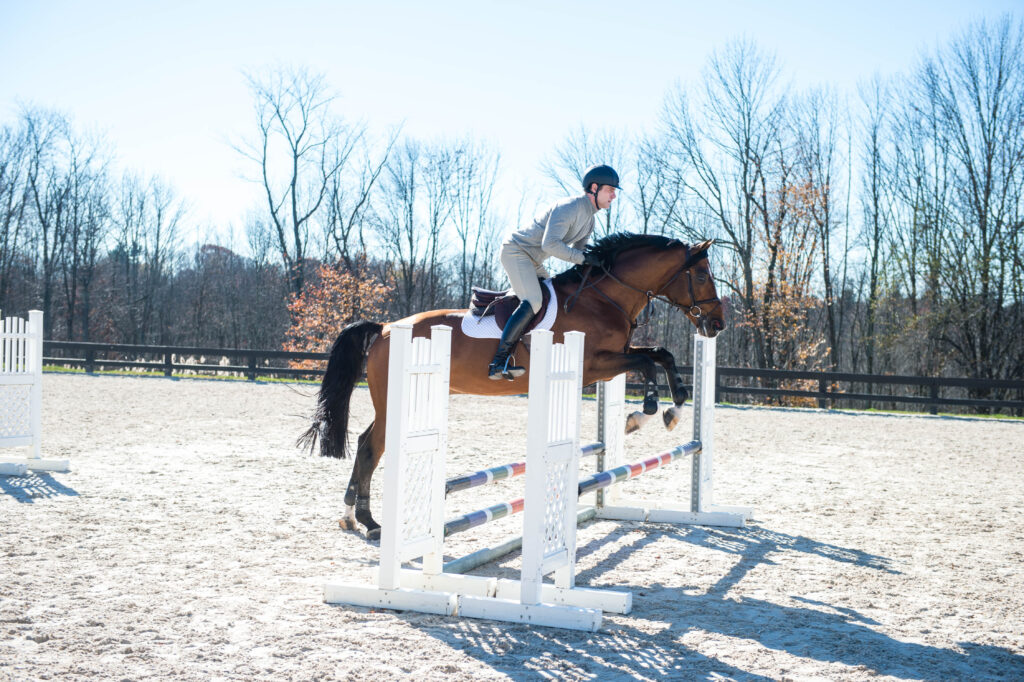
WEEK 4
Focus: Coursework, both on the grass and in the sand ring
Goal: Practicing elements and lines I expect to see in competition and reviewing lessons of previous weeks, if necessary
Requirements: Four jumps, consisting of both verticals and oxers, set up on a well-maintained grass surface; several additional jumps to create lines and combinations in the sand ring
This is fine-tuning week—the time to put all the lessons of the previous three
weeks together in mini-simulations of the courses we will encounter at the show. For this example, I set up four to five jumps in a small grass area next to our sand ring. It takes only a few jumps to give you an idea of how the bigger open space and varying terrain affect your horse’s balance, speed and steering.
In my sand ring, I set up any other lines or combinations that I suspect we will encounter at the show. Depending on the horse’s experience, I plan to do about two jump schools in Week 4, spending about half the time in the grass field and half in the ring. If necessary, I also make time to review any other lessons from previous weeks that I felt needed a little more attention.
If you are preparing for a different kind of venue, do your Week 4 jump schools in a space with an appropriately similar size and surface. For example, if your competition will be indoors, practice courses in an indoor. This will help you refine the correct sense of rhythm and timing for the smaller space.
By the end of these four carefully planned weeks, I know my horses are mentally and physically prepared for the competition. We have covered a lot of material in a gradual, logical way that should produce fresh, confident and successful performances.
Week 4: Jump School on Grass
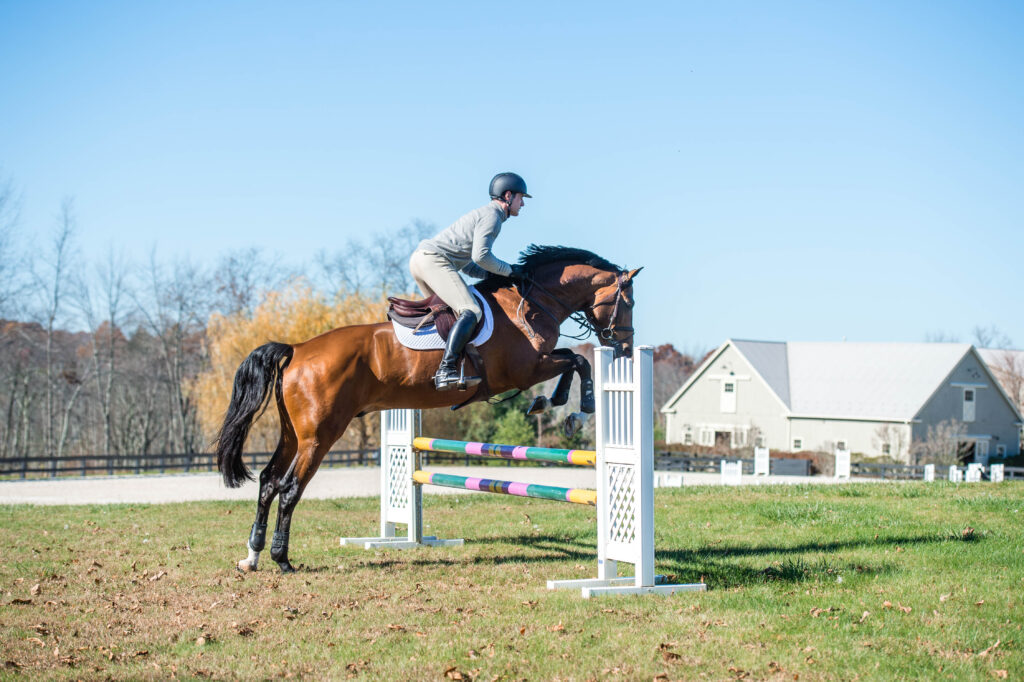
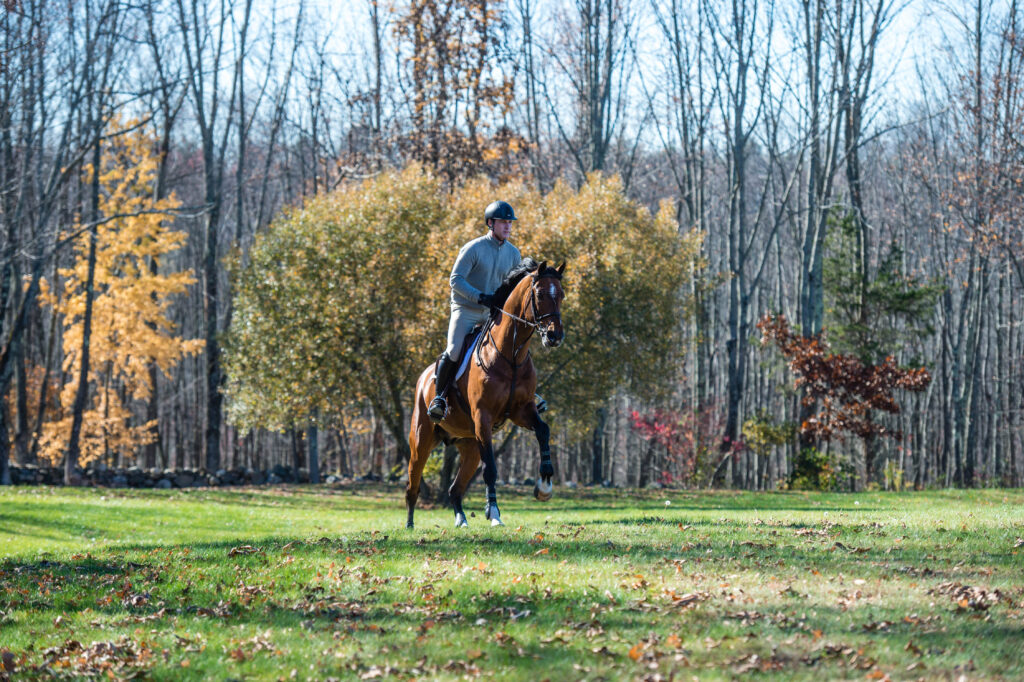
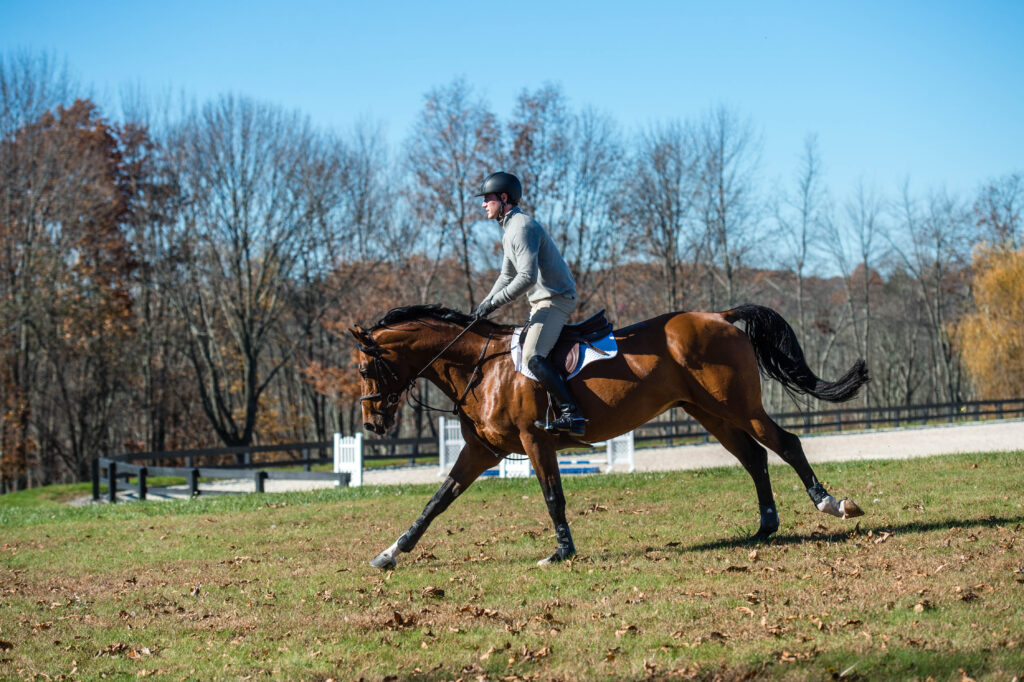
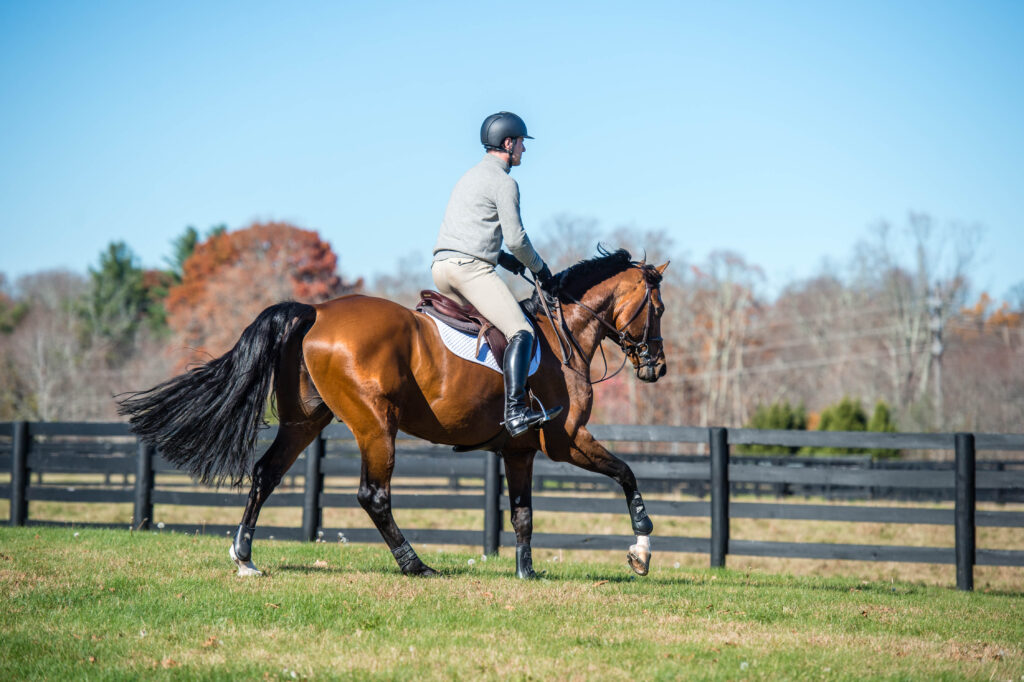
Week 4: Jump School on Grass
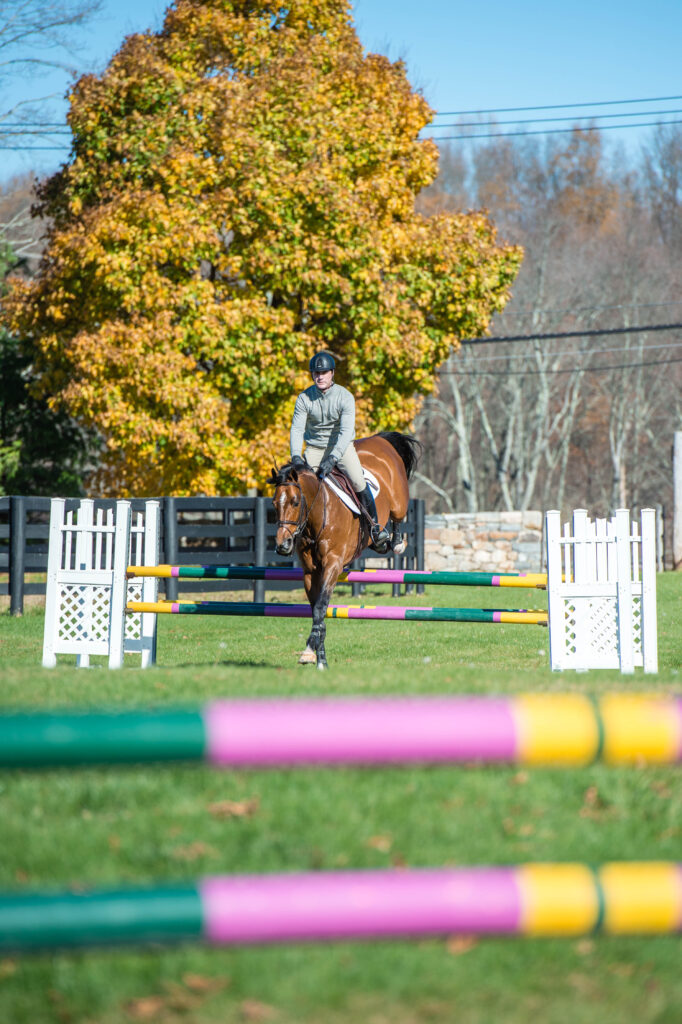
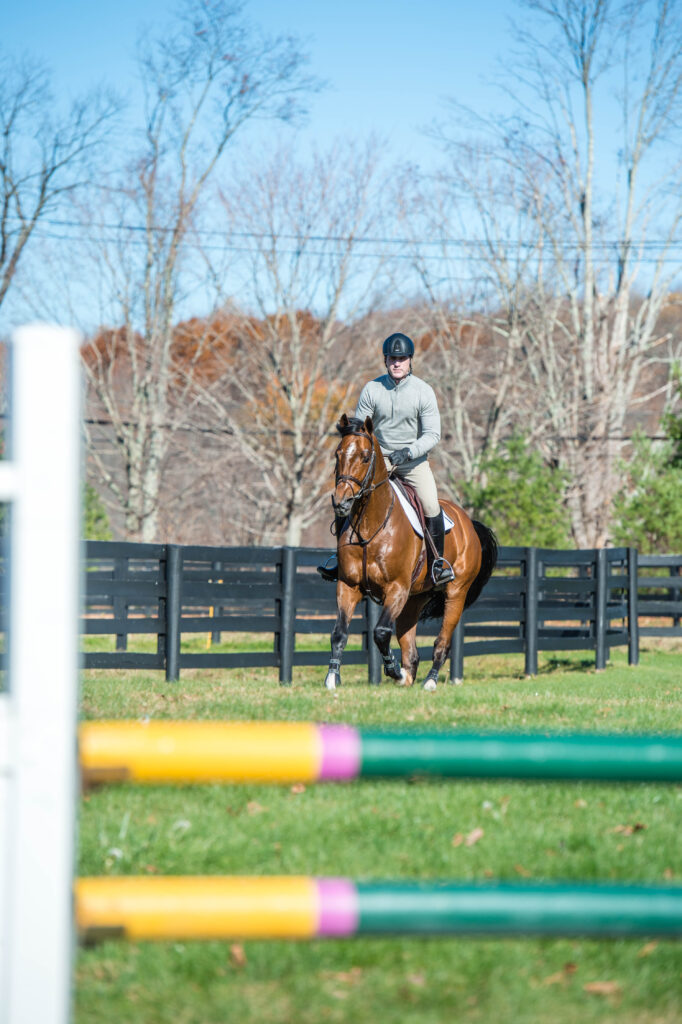
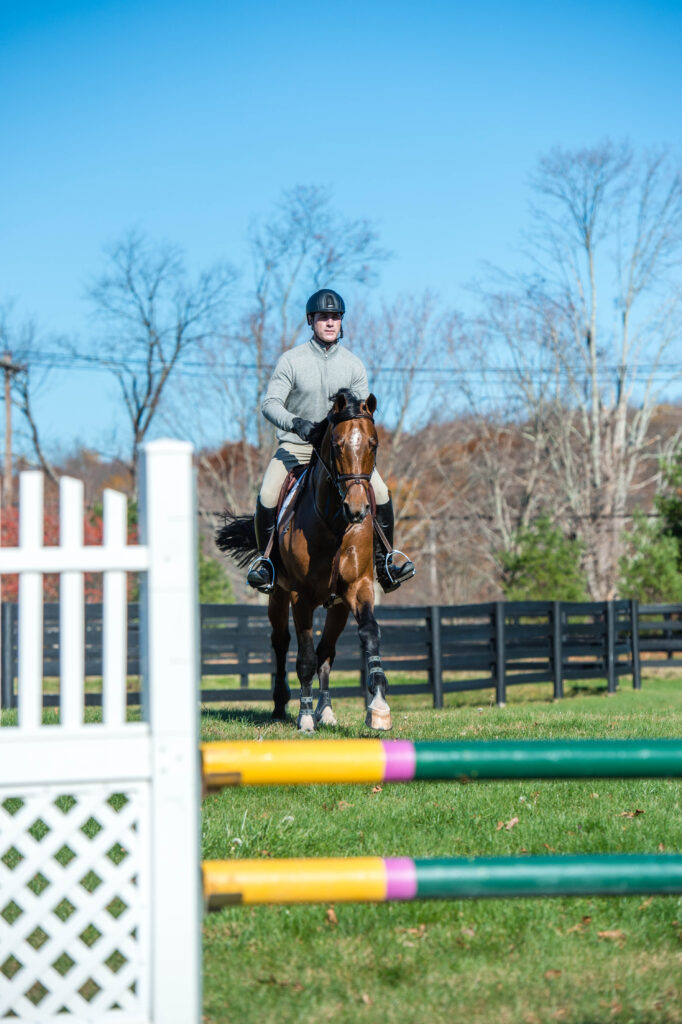
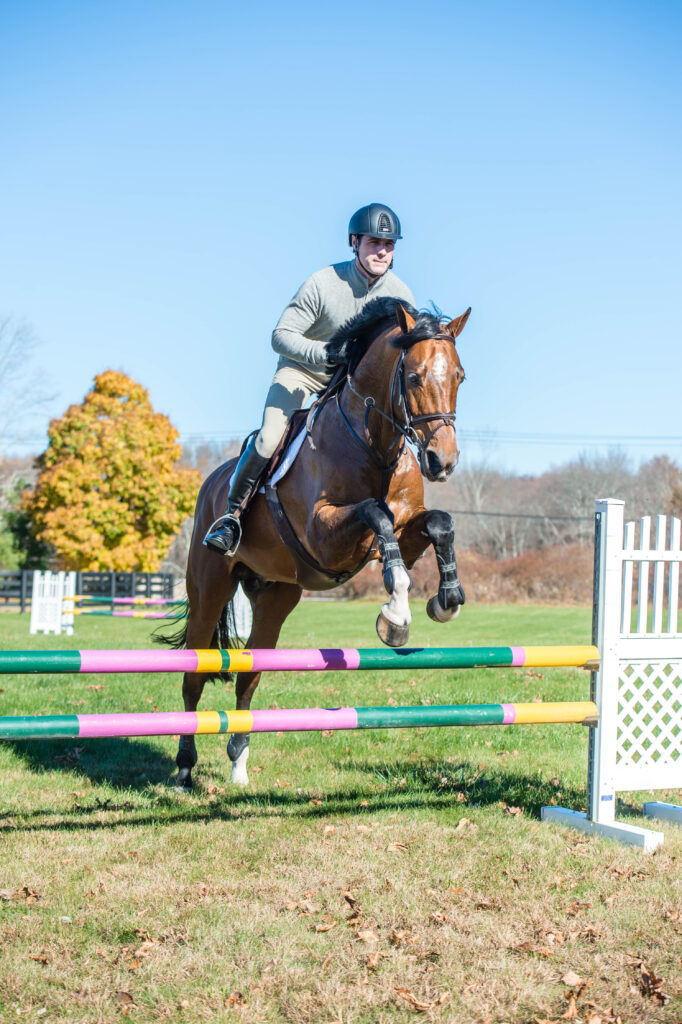
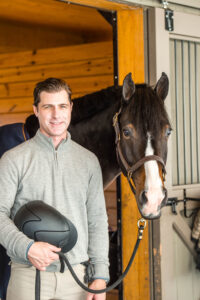
Peter Lutz understands challenges that lower-level amateurs and riders operating on tight budgets face. “I can relate to them because that was me until I was 16,” explains the equitation champion turned professional hunter/jumper trainer born “to parents who had never seen a horse.” When Peter was young, his family moved to Connecticut, where he took lessons from trainer/author Gincy Bucklin, who started beginners on horses wearing hackamores and bareback pads. “I did not see a saddle for the first six months,” he says. He moved on to lessons at the Fairfield County Hunt Club before meeting jumping and event trainer Sarah Dalton-Morris at age 12. “Sarah has been my mentor ever since.”
Sarah gave Peter a foundation in all-around general horsemanship. During those years, he joined the Pony Club, evented and trail rode on his first horse, a half-Arabian. When he was 16, equitation trainer Judy Richter spotted him at a Pony Club rally. “I watched him jump and went up to him and said, ‘You should come ride at Coker Farm,’” she recalls. “He said, ‘I’d love to but I can’t afford it.’ And I said, ‘Well you come run the in-gate at my horse show and we’ll give you a couple of lessons.’”
The “couple of lessons” stretched into a years-long working-student position with Judy and her assistant trainers at the time, Andre Dignelli and Kate Stoffel-Oliver. “I mucked stalls and groomed as a Junior,” Peter says. The hard work paid off: In 1991, he won both the ASPCA Maclay National Championship and the USET Medal East Finals.
He went on to attend Yale University but continued to ride and teach lessons throughout his college years. Before his sophomore year, he spent a summer training professionally in Switzerland.
After graduating, Peter rode and showed sales horses for Sam Edelman at S & L Farms. He then started a new training and sales stable, Davenport Horse Sales and Training, with business partner Mary Manfredi. Since then, he has trained such top riders as Clementine Goutal and her sister, equitation star Brianne; Saer and Audrey Coulter; and Kelly Tropin.
Peter’s own success in the show ring has continued. He won multiple ribbons at last year’s Old Salem Farm Spring Horse Show, including second and fourth placings, respectively, in the $20,000 and $15,000 Speed Derbies on Katherine Gallagher’s Carneyhaugh Manx. His top grand prix partner, Robin de Ponthual, owned by Michael Meller and Katherine, had many top placings in 2015. Robin finished third in the $85,000 American Gold Cup Qualifier and fourth in the $215,000 Longines FEI World Cup™ Jumping New York at Old Salem Farm. Two months later, he won the $100,000 Longines FEI World Cup™ Jumping Las Vegas. The Gold Cup took place on a large, grassy field while Las Vegas was indoors and packed with fans. “These were two very different events,” he says, “and the preparation for each was very specific.”
Also in 2015, Peter coached Kelly Tropin to the Amateur-Owner Hunter 3-foot-6, 18–35 division championship at the Washington International Horse Show and second place in the $50,000 iHeartMedia Hunter Derby in the grand prix ring at the Hampton Classic.
Although an integral part of Peter’s business requires him to sell many of his best horses, he is grateful for owners like Michael and Katherine and Kathleen Tropin, owner of up-and-coming grand prix horse Coberlina, who enable him to compete at the top levels.
This article originally appeared in the March 2016 issue of Practical Horseman.

